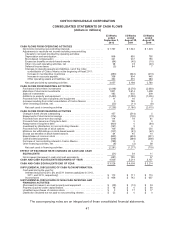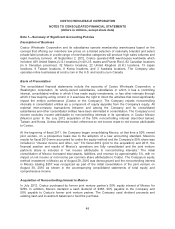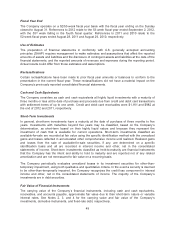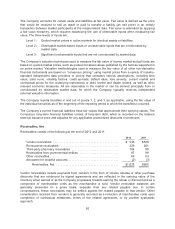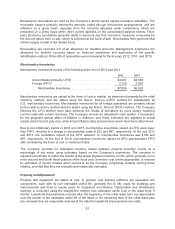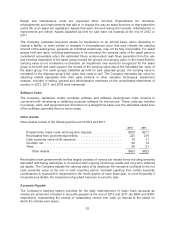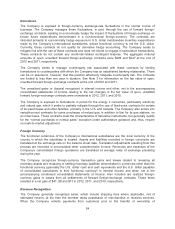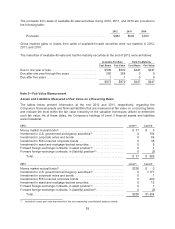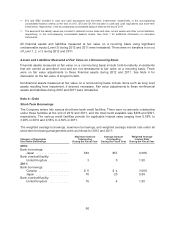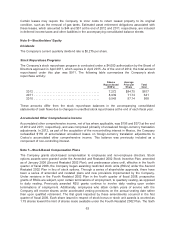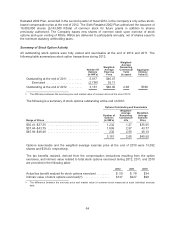Costco 2012 Annual Report Download - page 57
Download and view the complete annual report
Please find page 57 of the 2012 Costco annual report below. You can navigate through the pages in the report by either clicking on the pages listed below, or by using the keyword search tool below to find specific information within the annual report.merchandise or the performance of services, the amounts received are generally recorded as deferred
sales, included in other current liabilities on the consolidated balance sheets, until the sale or service is
completed. The Company reserves for estimated sales returns based on historical trends in
merchandise returns, net of the estimated net realizable value of merchandise inventories to be
returned and any estimated disposition costs. Amounts collected from members, which under common
trade practices are referred to as sales taxes, are recorded on a net basis.
The Company evaluates whether it is appropriate to record the gross amount of merchandise sales
and related costs or the net amount earned as commissions. Generally, when Costco is the primary
obligor, is subject to inventory risk, has latitude in establishing prices and selecting suppliers, can
influence product or service specifications, or has several but not all of these indicators, revenue and
related shipping fees are recorded on a gross basis. If the Company is not the primary obligor and
does not possess other indicators of gross reporting as noted above, it records the net amounts as
commissions earned, which is reflected in net sales.
Membership fee revenue represents annual membership fees paid by substantially all of the
Company’s members. The Company accounts for membership fee revenue, net of estimated refunds,
on a deferred basis, whereby revenue is recognized ratably over the one-year membership period. The
Company’s Executive Members qualify for a 2% reward (beginning November, 1, 2011 the reward
increased from a maximum of $500 to $750 per year on qualified purchases), which can be redeemed
at Costco warehouses. The Company accounts for this reward as a reduction in sales. The sales
reduction and corresponding liability are computed after giving effect to the estimated impact of
non-redemptions based on historical data. The net reduction in sales was $900, $790, and $688 in
2012, 2011, and 2010, respectively.
Merchandise Costs
Merchandise costs consist of the purchase price of inventory sold, inbound and outbound shipping
charges and all costs related to the Company’s depot operations, including freight from depots to
selling warehouses, and are reduced by vendor consideration. Merchandise costs also include
salaries, benefits, and depreciation on production equipment in fresh foods and certain ancillary
departments.
Selling, General and Administrative Expenses
Selling, general and administrative expenses consist primarily of salaries, benefits and workers’
compensation costs for warehouse employees, other than fresh foods departments and certain
ancillary businesses, as well as all regional and home office employees, including buying personnel.
Selling, general and administrative expenses also include utilities, bank charges, rent and substantially
all building and equipment depreciation, as well as other operating costs incurred to support
warehouse operations.
Marketing and Promotional Expenses
Marketing and promotional costs are expensed as incurred and are included in selling, general and
administrative expenses in the accompanying consolidated statements of income.
Stock-Based Compensation
Compensation expense for all stock-based awards granted is recognized using the straight-line
method. The fair value of restricted stock units (RSUs) is calculated as the market value of the
common stock on the measurement date less the present value of the expected dividends forgone
during the vesting period. The fair value of stock options was measured using the Black-Scholes
55




